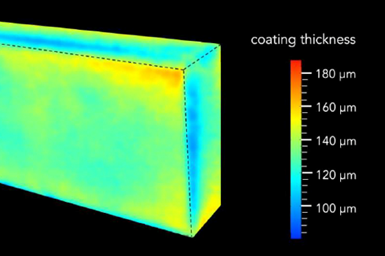Spatial Coating Thickness Measurement Solution for Prismatic Battery Cells
Coatmaster AG’s 3D noncontact coating thickness measurement system employs ATO technology to provide spatial measurement of coating thickness.
#energy #measurement-testing
Edited by

Coating thickness distribution on battery cell with noncontact coating thickness measurement technology. Photo Credit: Coatmaster AG
Responding to the need for better insulating coatings on prismatic battery cells, Coatmaster AG has developed the Coatmaster 3D noncontact coating thickness measurement system. The tool employs advanced ATO technology to provide spatial measurement of coating thickness across all side faces and edges inline within a split second, confirming uniform thickness throughout the cell.
The manufacturing of prismatic battery cells, which are indispensable to the e-mobility industry, involves a specific cuboid geometry. A key component of these cells is an insulating coating, the minimum thickness of which is crucial for maintaining electrical isolation. However, industry-wide issues have plagued the accurate measurement and assurance of minimal thickness, especially at the cell edges. These issues are compounded by varying factors, such as viscosity, surface tension, curing behavior, edge curvature and the spatial spray pattern of the coating gun.
Past approaches attempted to measure the coating thickness on the cell’s side faces, anticipating a correlation between these values and those at the edges. However, recent studies show only a weak correlation due to the above variables. Additionally, the position of the minimum thickness along the edges is not constant, necessitating a spatial approach to measuring coating thickness. Aware of this, battery manufacturers carry out additional visual control of the edges, which generates additional costs and resources.
“Coatmaster 3D is a major leap forward in the prismatic battery cell production landscape,” says Andor Bariska, co-CEO of Coatmaster AG. “Not only does it enhance efficiency and quality control but it also significantly improves the safety and reliability of e-mobility solutions.”
Multiple initiatives are in progress to substitute the previous, inadequate measurement technologies with the Coatmaster 3D solution. In a short period, Coatmaster 3D has emerged as the new industry standard, the company says. Through its technology and approach, Coatmaster AG says it aims to usher in a new era of prismatic battery cell manufacturing, underscoring its commitment to advancing the industry standards.
RELATED CONTENT
-
Digital Mobile Metrology Device Captures 2D, 3D Surface Maps in Milliseconds
GelSight Max, a portable digital metrology device, enables users to take repeatable measurements of roughness values down to the submicron level.
-
Appearance Solution Measures, Visualizes Effect Finishes
X-Rite MA-T12 spectrophotometer and Pantora software characterize complex material finishes in molded plastics, leathers and coatings to improve virtual prototyping and quality control.
-
Analyzer for Smart Coatings and Connected Measurements
The analyzer includes a proportional counter detector for routine measurements of common platings and incorporates advanced user-friendly features designed to enhance high-volume testing.
















